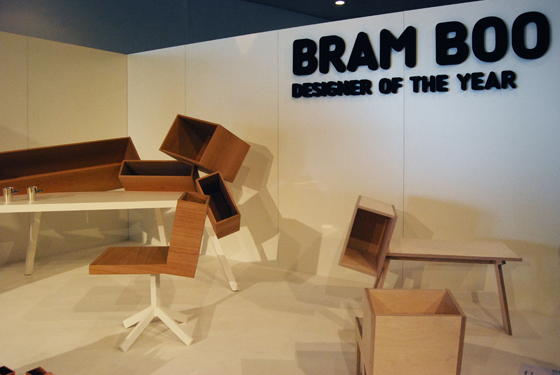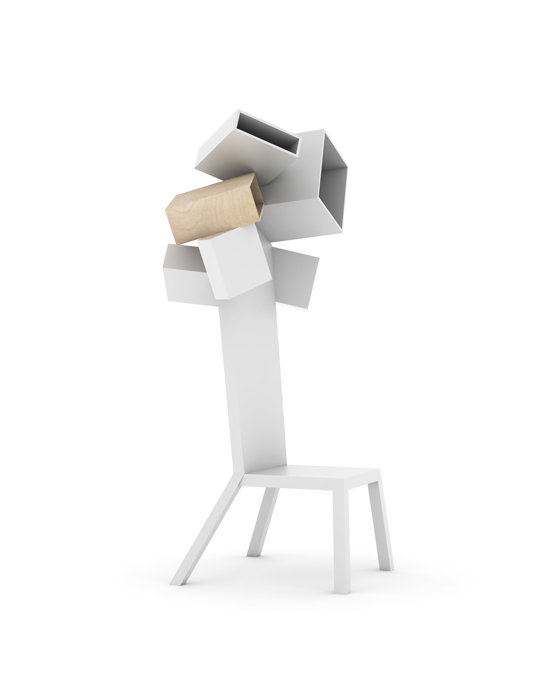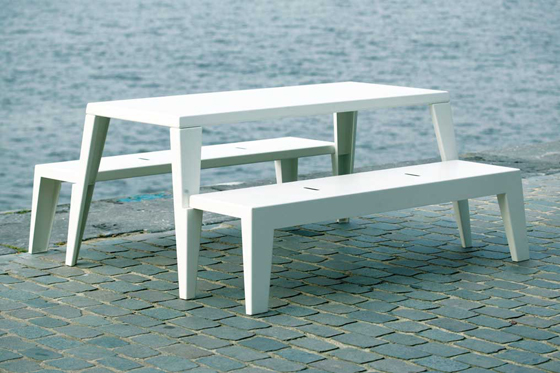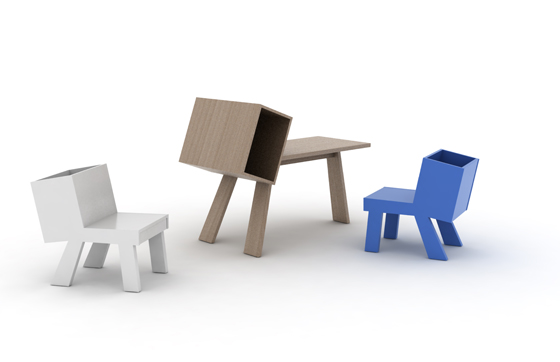'There shouldn't be one rule about how to make furniture': in conversation with Interieur 2010 Designer of the Year Bram Boo
Texto por Simon Keane-Cowell
Zürich, Suiza
03.11.10
He's big in Belgium. And increasingly elsewhere, thanks to him being named Designer of the Year by prestigious design biennale Interieur 2010. Bram Boo's furniture designs delight and challenge in equal measure with their chaotic, often ironic, forms, which belie their resolutely practical functionality. Architonic made a date with the Belgian designer in Kortrijk to discuss his typology-troubling work.
It's every journalist's worst nightmare. You arrange to interview a designer of the moment at a busy design fair. You turn up with a belly full of excitement and a head full of questions, ready to chew the creative cud. And then your dictaphone suddenly decides not to work. Why me, Lord?
Luckily, when I met up with Bram Boo at the Interieur 2010 design biennale in Kortrijk recently with a non-functioning recording device in hand, the Belgian designer, who was awarded the covetable title of 'Designer of Year' by the prestigious fair, showed himself to be a man of grace and patience. A quick scout around for a replacement gadget proved fruitful and so we began to make up for lost time.
'After ten years of hard work, it's a nice present to receive a title like this': Designer of the Year Bram Boo at the Interieur 2010 design biennale in Kortrijk; photo Nicolas Schimp

'After ten years of hard work, it's a nice present to receive a title like this': Designer of the Year Bram Boo at the Interieur 2010 design biennale in Kortrijk; photo Nicolas Schimp
×Bram Boo (as far as alliterative, monosyllabic names go, his takes some beating) creates furniture that could be described as a little bit shifty. Their somewhat chaotic, kinetic forms leave you with the impression that they are in flux or on the move, that they could walk out on you at any moment. Injecting his inanimate objects with a good dose of the animate is one way that Boo's work manages to 'interpolate', as he puts it, its users, to address them, and, in doing so, to make them conscious of the material culture that surrounds them. 'People are exciting. Why can't furniture also be exciting?,' asks the designer.
But don't be fooled. Boo's, at times highly sculptural and often humorous, pieces are informed first and foremost by their utilitarian function. They may appear strange in the sense of being unfamiliar, but they work well. The visual challenge that they present is attended by a high degree of consideration in terms of their practical usefulness. To dismiss Boo's furniture as mere whimsy would be an error.
'Boo Boo', Bram Boo's new red-hot desk and chair for very cool Belgian brand FELD; his 'Etcetera' table in background
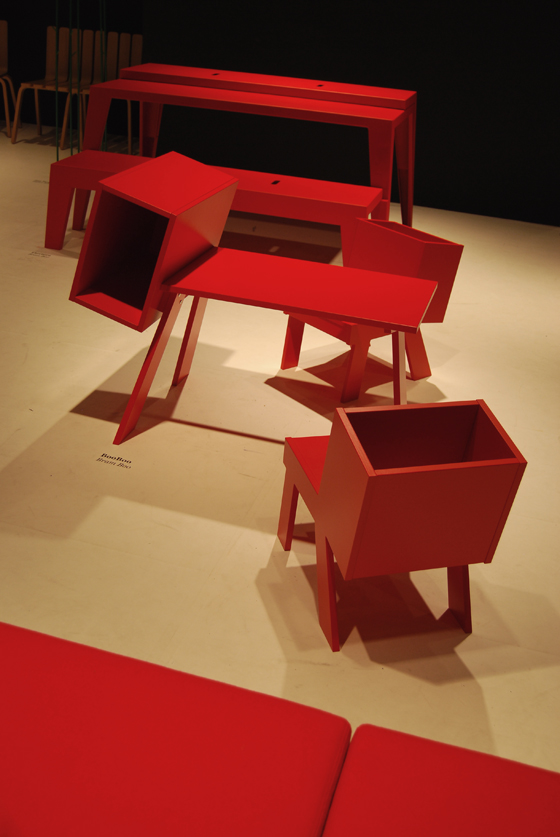
'Boo Boo', Bram Boo's new red-hot desk and chair for very cool Belgian brand FELD; his 'Etcetera' table in background
×What lies at the centre of the Belgian designer's ongoing work, ultimately, is his questioning of the received typology of furniture, his attempt to subvert what we have come to recognise as object types. ('This is what a chair looks like.' 'This is how a desk should be.' And so on.). A number of Belgian design brands, such as FELD, BULO and Indera, have recognised just what is at stake in Boo's designs and have put them into production. His furniture can also be found in the entrance hall to the Brussels Parliament building.
In the following in-depth interview, Boo talks to Architonic about the relation in his work between the functional, the aesthetic and the emotional, why stepping into and out of the industrial-production system is good for creativity, and the meaning (or not) of Belgian design. Oh, and why we might be just a little bit happier if we simply made everything ourselves...
Ordered chaos: 'Overdose' desk by Bram Boo for Belgian design-led office-furniture manufacturer Bulo
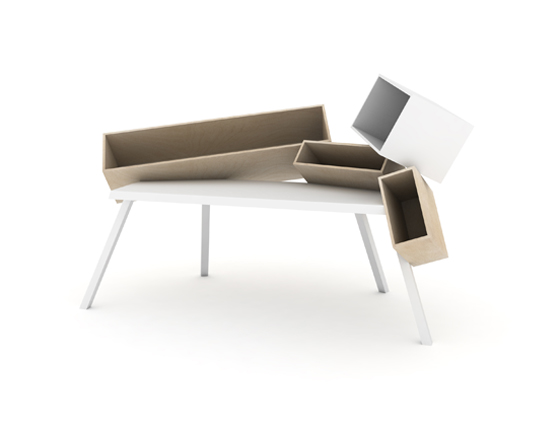
Ordered chaos: 'Overdose' desk by Bram Boo for Belgian design-led office-furniture manufacturer Bulo
×.....
Congratulations on being named Designer of the Year.
It's a great honour for me.
What does the accolade mean to you, beyond it being a very large compliment?
Well, after ten years of hard work, it's a nice present to receive a title like this. But, of course, it also helps you to continue to grow. You make new contacts.
You're in good company, with previous Designers of the Year such as Alain Berteau and Sylvain Willenz.
I think I'm a little bit different from the others, as I see design as an industrial process but also as an experimental way to express what furniture can be. The others didn't quite work in that way.
Bram Boo's Designer of the Year installation at this year's Interieur 2010 design biennale
Can we talk about how you perceive the role of furniture? Your work is intriguing from the moment you look at it. It's functional, but where function meets a somewhat provocative set of aesthetics. And then there's the emotional valence your designs carry. What is the relationship between all of these?
I'm always looking for a mix of these elements. Emotion, function, comfort. I'm trying to create furniture that interacts with people. If you make a simple piece of furniture, people just walk around it. They don't look at it. Like it's nothing. But making furniture in another way means people think about it a little bit when they see it. I think that's important.
I grew up in a family where we had pieces of Ettore Sottsass from the Memphis period. But there were also very simple, more industrial pieces like Charles and Ray Eames or Joe Colombo. I think a mix of these kinds of things create a sense of excitement all around you. People are exciting, but why can't furniture also be exciting. You can also play with that.
Boo's 'Overdose' storage demonstrates the continued evolution of a distinctive formal language: 'My work is building on itself...I'm not looking after it. It's coming intuitively,' says the designer
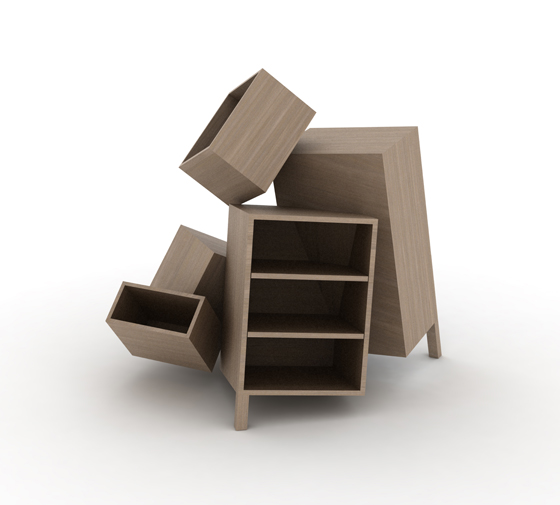
Boo's 'Overdose' storage demonstrates the continued evolution of a distinctive formal language: 'My work is building on itself...I'm not looking after it. It's coming intuitively,' says the designer
×Do you consciously want to make the users, or even viewers, of your furniture do some work when it comes to encountering your designs?
Well, I try to push a bit further than functional aspects. But, in a way, if you have a piece of furniture, like the 'Overdose' desk, you will soon play with it in a way. You are creating another kind of movement around the furniture. Instead of having the storage under your desk, it's above it in a quite chaotic way. Creativity should mean a richness of diversity. If we are all doing the same thing, it's boring. There shouldn't be one rule about how to make furniture. To try to make something in a different way draws people in. Surprise and laughter.
Pleasure plays an important role, then?
I try to achieve this with function and not through decoration. The decorative emerges from the way I address function.
Normally when you think of chaos, you think of the absolute opposite of pleasure and comfort. Would the notion of ordered chaos, of opposites held in tension, be an appropriate way to describe your work?
Yes. That's why my furniture looks a bit strange. But I love to create work like this.
Boo's 'Overdose' chair completes the 'chaotic' collection; photo Bram Boo
You mentioned the industrial process. How committed are you to this? What value do you place on limited-edition design and one-offs?
I think in my case I'm happy with both ways of working. I'm not about to make a limited-edition piece straight away. Not at all. But, when you have an idea for a product, it finds its own way. But sometimes it's important to do something special, like for a show in Milan. If you only work in an industrial way, it closes a lot of doors. If you mix things, you feed your creativity. And I need that. I was very free working on my 'Paparazzi' office chair, which features bins on either side of it. And that gave me the idea for the 'Overdose' desk, which has been taken into production by Bulo. So one interacts with the other.
Normally when you are making something very special, it's not going to find a place in the industrial world. Do you then stop and not produce it? It's just a pity that limited-edition design is sometimes so expensive. But it's not possible another way.
So, it's a case of stepping out of system of industrial production in order to develop an idea that is brought back into that system at a later stage.
Well, the two ways – industry and handcraft – still exist and both have their possibilities. We have to use both. You shouldn't limit your creativity. An experimental object tests what an object can be. It develops your mind and the way you see things. It feeds me.
The Belgian designer's 'Paparazzi' office chair, which was the creative starting point for his later 'Overdose' collection; photo Bram Boo

The Belgian designer's 'Paparazzi' office chair, which was the creative starting point for his later 'Overdose' collection; photo Bram Boo
×Your work has a particular formal language. Are you consciously trying to develop a particular 'style', if that's a valid term?
There's certainly a development in my work, but it's still going on, slowly. I'm not looking after it. It's coming intuitively. But I can see that my work is building on itself. First, the collection of 'Gypsy Things', then the 'Lazy' desk, the 'Paparazzi' and the 'Overdose' collection. It's an evolution that is happening naturally.
What's your assessment of current design activity in Belgium?
There are a lot of Belgian brands established in the last couple of years and it has given Belgian designers certain opportunities. Things are moving quite quickly, helping to develop Belgian design, in a way – even though it's difficult to say what is typical Belgian design. Belgium is a small country with a lot of big ones around it. Typical of Belgium, maybe, is being individual. Perhaps it's because of the political situation that we have to do something on our own and to develop it. And it must have a strong identity so it can be exported. Belgium is too small to have its own market here. So we always have to think larger. And this helps us perhaps to be a bit different, to think differently. I think this kind of problem helps creativity.
I think it's hard to typify design along national lines at the best of times. I'm not sure it's even a worthwhile undertaking.
I think Belgian design, if it's anything, is diversity.
Produced by Belgian design label FELD, Bram Boo's aluminium indoor/outdoor 'Etcetera' table
I was about to say. Belgium, for me, in terms of design, seems to be revealing itself as a site of creative practice that doesn't have any one singular identity.
It's really a country of individually minded creative people trying to do their best. Belgian design schools don't give their students a particular path to follow, like in Eindhoven or Switzerland. It's quite democratic. They say 'Look around you.' In Belgium, when you stop school you're on your own and you have to be individual to develop yourself and to charm other people. So there's a difference.
And why is it different here?
I think because of the political situation. The quarrel between the Flemish and the Walloons makes it difficult to have budgets for those schools, to invest more. But money isn't the best tool for creativity. Creativity responds to problems, and when you don't have a problem, it's much more difficult. Rich people aren't so creative.
Are you optimistic about design manufacturing in Belgium? Does it have a future?
Yes, I can feel it with a lot of design labels. They try to produce in China and then there are problems with the quality. And then they lose money. But at home, just ten kilometres away, there is someone who can do it very well. It's a little bit more expensive, but you don't waste time and it's a good quality. That's the first advantage. But also it's a more ecological way to work. We have to try to work in a local situation. If it's possible, why not?
How conscious are you as someone who is responsible for creating objects that are then produced industrially of their environmental effects?
It's a huge problem.
Bram Boo's somewhat anthropomorphic furniture collection, 'The Gypsy Things': 'They have their own characteristics – inventive, familiar, proud and full of irony,' says Boo
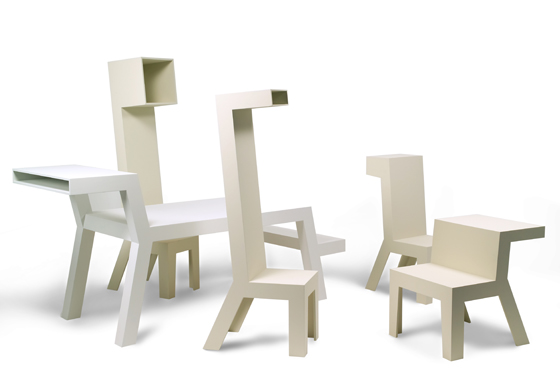
Bram Boo's somewhat anthropomorphic furniture collection, 'The Gypsy Things': 'They have their own characteristics – inventive, familiar, proud and full of irony,' says Boo
×Do we need all these objects?
I think we do. If we were to quickly solve the problem, we'd be going back to some kind of communist way: everyone has the same car, kind of thing. But then creativity will disappear. Then we are all the same. And we won't be happy. So we have to solve it in another way. And also to communicate to people to take care of your products and try to buy something a little bit more expensive but that you really love and that you live with for longer.
As a designer, I always try to communicate with design labels and producers in that way, but the problem has to be solved in the first place by our political leaders, to give us direction. It's everybody or nobody. In China they have to follow this direction, in Europe they have to follow that kind of vision. And then we are on the same train. And then creativity can help to provide difference.
I guess we are all human and full of contradictions. We continue to fetishise objects, to consume at an insatiable rate, while knowing that this can't last forever.
Well, we don't want to lose our way of life, the way new things make us happy. And the fact there are too many of us is a fundamental problem. But if just stop manufacturing products, there will be a lot of people on the street. But there is a lot of dialogue already about all of this, so that is positive. The economic crisis has come at the right time perhaps, as it allows us really to think about things.
The 'Boo Boo' collection of children's furniture for FELD, in different colours
Formally, your furniture designs are very kinetic. But also quite zoomorphic. Like they are on the move, or, rather, sitting up and ready to get going.
It's strange. This isn't intentional. For example, my 'Gypsy Things' collection looks a bit like a group of people, like they have heads. But this comes from the combination of functions. If you look at ourselves, we are only functions. Our heads, our eyes, our ears. If you add more function to a table, it will look more like us. You suddenly will have a kind of silhouette that reminds us of an animal. Function is quite close to us. A material is dead, but if you play with it and add some different functions together, it will soon look like something that already exists, that is living.
Well, a lot of objects are extensions of us. A tool is an extension of our hands...
Objects are very close to us. They are integrated into our lives, but we are so busy now we sometimes don't see them anymore. But I think they have an impact on our day, the way we view things, the way we think about things.
Indeed. And anything that helps us live in the moment and be more aware of it is a good thing. We're far too concerned with what we can consume next, how we want our futures to be.
I wanted to be a designer to have a rich life. Not to be rich. We are all too materialistic, buying a lot of objects to enrich our environments. As a designer I shouldn't say this probably, but it's better to make it yourself. (Laughs.) To enrich yourself.
The way to find happiness is complex. Buying a new item of clothing might make you happy for a few days, but then you need something else. Making something yourself and enjoying yourself while doing it, so you don't need to buy it – I think this can help us to be happier.
Let's make something now.
(Laughs.) Why not?
It was a pleasure to talk to you, Bram. Thank you.
.....



